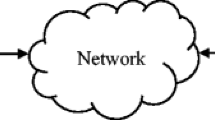Abstract
Detection and isolation of failures in large and complex systems such as telecommunication networks are crucial and challenging tasks. The problem considered here is that of diagnosing the largest French packet switching network. The challenge is to be as efficient as the existing expert system while providing greater generality and flexibility with respect to technological and reconfiguration changes in the network. The network is made up of interconnected components each of which can send, receive and transmit messages via its ports. The problem we are faced with is to follow the evolution of the network on the basis of the stream of time-stamped alarms which arrive at the supervision center. We have decided to use model-based techniques which are recognized to be more adapted to evolutive systems than expertise-based approaches are. This paper starts with a description of how we model the global behavior of this discrete-event system by using communicating finite state machines. It goes on to explain how this model is used for analyzing the stream of alarms and diagnosing the network. Our work is based on the diagnoser approach proposed by Sampath et al. (1995). Starting from a model of the network adapted to simulate faults, this approach transforms it into a finite state automaton, called a diagnoser, in order to analyze the stream of alarms. The approach described in Sampath et al. (1995; 1996) proved to be grounded on certain basic hypotheses which were too restrictive for our application. This paper extends Sampath's proposal to communicating finite state machines. The difficulties we had to cope with are outlined and the way we overcome them is presented. A major difficulty is the huge size of the global model of the system. To solve this problem we take advantage of the hierarchical structure of the network and rely on a generic model of the system for building a generic diagnoser.
Similar content being viewed by others
References
Alur, R., and Dill, D. L. 1990. Automata for modeling real-time systems. Proceedings of I-CALP'90, LNCS 443, Springer-Verlag, pp. 321–335.
Baroni, P., Lamperti, G., Pogliano, P., and Zanella, M. 1998. Diagnosis of active systems. Proceedings of the European Conference on Artificial Intelligence (ECAI), pp. 274–278.
Bibas, S. 1997. Simulation à base de modèles pour la supervision de réseaux de télécommunication. Ph.D. thesis, Université Paris-Nord.
Bibas, S., Cordier, M. O., Dague, P., Lévy, P., and Rozé, L. 1996. Gaspar: a model-based system for diagnosing telecommunication networks. IMACS-IEEE/SMC International Multiconference of Computational Engineering in Systems Applications (CESA'96), Lille, France, pp. 338–343.
Bibas, S., Cordier, M. O., Dague, P., Lévy, P., and Rozé, L. 1996. Modelling a telecommunication network for supervision purposes. Proceedings of the ECA196 Workshop on Model-Based Systems and Qualitative Reasoning—Perspectives for Industrial Applications, Brighton, UK, pp. 160–166.
Brand, D., and Zafiropulo, P. 1983. On communicating finite state machines. Journal of ACM 30: 323–342.
Brandin, B. A., and Wonham, W. M. 1994. Supervisory control of timed discrete event processes. IEEE Transactions on Automatic Control 39(2): 329–342.
Bratko, I. Mozetic, I., and Lavrac, N. 1988. Automatic synthesis and compression of cardiological knowledge. Machine Intelligence, Ellis Horwood, 11: 435–454.
Chen, Y. L., and Provan, G. 1997. Modeling and diagnosis of timed discrete event systems—a factory automation example, submitted.
Debouk, R. Lafortune, R., and Teneketzis, D. 1998. A coordinated decentralized protocol for failure diagnosis of discrete-event systems. 4th International Workshop on Discrete-Event Systems, Cagliari, Italy, pp. 138–143.
Dousson, C., Gaborit, P., and Ghallab, M. 1993. Situation recognition: representation and algorithms. Proceedings of the International Joint Conference on Artificial Intelligence (IJCAI), Chambéry, pp. 166–172.
Laborie, P. 1997. Automatic generation of chronicles and its application to alarm processing in power distribution systems. Proceedings of the International Workshop on Principles of Diagnosis (DX'97), Mont St Michel, France.
Niebur, D. 1990. Expert systems for power system control in western Europe. Proceedings of the IEEE Symposium on Intelligent Control, pp. 112–119.
Pearce, D. A. 1988. The induction of fault diagnosis systems from qualitative models. Proceedings of the AAAI National Conference on Artificial Intelligence, St Paul, pp. 353–357.
Pencolé, Y. 2000. Decentralized diagnoser approach: application to telecommunication networks. Proceedings of the International Workshop on Principles of Diagnosis (DX'00), Morelia, Mexico.
Riese, M. 1993. Diagnosis of extended finite automata as a dynamic constraint satisfaction problem. In Proceedings of the International Workshop on Principles of Diagnosis (DX'93), Aberystwyth, UK, pp. 60–73.
Rozé, L. 1997. Supervision de réseaux de télécommunications: une approache à base de modèles. Ph.D. thesis, Université de Rennes 1.
Sampath, M., Sengupta, R., Lafortune, S., Sinnamohideen, K., and Teneketzis, D. 1994. A discrete event systems approach to failure diagnosis. Proceedings of the International Workshop on Principles of Diagnosis(DX'94), New Paltz, USA, pp. 269–277.
Sampath, M., Sengupta, R., Lafortune, S., Sinnamohideen, K., and Teneketzis, D. 1995. Diagnosability of discrete event systems. IEEE Transactions on Automatic Control 40(9): 1555–1575.
Sampath, M., Sengupta, R., Lafortune, S., Sinnamohideen, K., and Teneketzis, D. 1996. Failure diagnosis using discrete event models. IEEE Transactions on Automatic Control 4(2): 105–124.
Author information
Authors and Affiliations
Rights and permissions
About this article
Cite this article
Rozé, L., Cordier, MO. Diagnosing Discrete-Event Systems: Extending the “Diagnoser Approach” to Deal with Telecommunication Networks. Discrete Event Dynamic Systems 12, 43–81 (2002). https://doi.org/10.1023/A:1013335803945
Issue Date:
DOI: https://doi.org/10.1023/A:1013335803945




